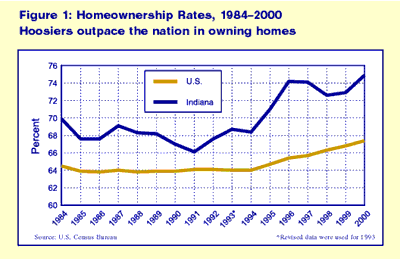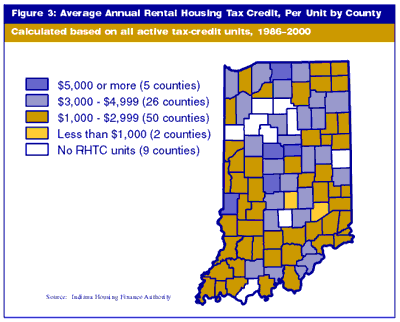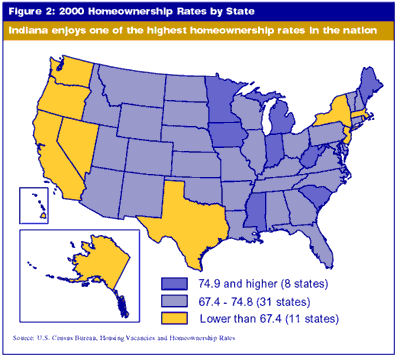Hoosiers and Affordable Housing: The Indiana Housing Finance Authority
The Indiana Housing Finance Authority (IHFA) works to address the entire spectrum of housing needs, from homeless shelters to rental to homeownership. But the impact of its programs reaches far beyond housing. Decent, safe and affordable housing creates stability in both families and communities. Such stability can have a direct impact on a family member's employment, a child's education and investment in a neighborhood.
IHFA's partners in the affordable-housing industry include realtors, lenders, for-profit and not-for-profit developers, community development corporations, local units of government, investors, investment bankers, federal and state agencies, tenants and legislators.
IHFA was created by the Indiana General Assembly in 1978, receiving no state revenues for its programs or operations. All of IHFA's resources are federal and include an allocation of private activity bonds from the Indiana Development Finance Authority for single-family programs, Rental Housing Tax Credits, the HOME Investment Partnerships Program (HOME) and Community Development Block Grant (CDBG) funds. IHFA's financial soundness has earned an Aaa rating for single-family bonds and an Aa3 rating for general obligations/issuer bonds.
In 2000 IHFA committed $351 million in resources to stimulate $445 million in investment in housing-related activities, including rehabilitation, new construction and mortgage financing. IHFA's programs fall into three areas: Homeownership, Community Development and Rental Housing.
Homeownership
Indiana enjoys one of the highest homeownership rates in the country. At 74.9% in 2000, Indiana ranked eighth highest in homeownership rates in the country, well above the national average of 67.4% (see Figure 1 and Figure 2).

IHFA's Impact in 2000Homeownership
Community Development
Rental Housing
|
To help low- and moderate-income families become first-time homebuyers, IHFA administers a program of below-market-interest-rate mortgages, Mortgage Credit Certificates (MCCs) and down-payment assistance. MCCs are tax credits that homeowners can claim on a percentage of the interest they pay on their mortgage each year. Both the mortgage program and MCCs are made possible through private activity bond allocations. Down-payment assistance is financed primarily with HOME funds.
Community Development
IHFA's Community Development programs support a variety of housing activities with federal HOME and CDBG funds and Indiana's Low Income Housing Trust Fund. The housing activities supported through these programs include emergency shelters, youth shelters, transitional housing, migrant/seasonal farmworker housing, rental housing, homeownership counseling, down-payment assistance, homeownership and owner-occupied rehabilitation.
To assist local units of government and Community Housing Development Organizations (CHDOs) plan and prepare for housing activities, IHFA also funds housing-needs assessments, feasibility studies and predevelopment loans. Additional funds are awarded to CHDOs for operating funds.
Rental Housing
For many seniors and young people—both growing sectors of Indiana's population—renting can be preferable to owning. The two primary programs that IHFA administers to provide financial incentives for developers to build or rehabilitate affordable rental housing are Rental Housing Tax Credits (RHTCs) (see Figure 3) and Multifamily Bonds.
Click on map to see larger version with data.

RHTCs are authorized by Section 42 of the Internal Revenue Code. RHTCs can be used as a credit on a developer's federal tax return or can be sold to investors to raise equity for a development. Multifamily Bonds are a form of private-activity bond that is tax-exempt and issued by state or local governments. The interest on these bonds is generally tax-exempt, which is attractive to investors and typically results in lower financing costs and interest rates for the developer. Both programs are administered on a competitive basis to for-profit and not-for-profit developers. As a requirement of the programs, the units developed with these resources must be rented at affordable rates for at least 15 years.
As well as creating new rental housing units, IHFA is very concerned about
the preservation of existing affordable rental units. Because of this, IHFA
became the Participating Administrative Entity (PAE) in the U.S. Department
of Housing and Urban Development's (HUD's) Mark-to-Market program. This program
is designed to restructure the rent or debt of property-based Section 8 developments
in order to keep them in the Section 8 program when their contracts expire.
To date, IHFA has successfully kept 625 units in eight properties in the Section
8 program.
In addition, effective Oct. 1, 2000, IHFA became the contract administrator for 292 Section 8 property-based contracts in Indiana. This is part of HUD's efforts to decentralize their responsibilities and assign them to statewide organizations.
Looking ahead
Late in 2000, the U.S. Congress passed legislation that will significantly expand some of IHFA's programs. This legislation, the Consolidated Appropriations Act for 2001, increased the cap on the amount of RHTCs that can be allocated in a state from $1.25 per capita to $1.50 per capita effective Jan. 1, 2001, and to $1.75 per capita effective Jan. 1, 2002. The cap on private-activity-bond volume was also increased from $50 per capita to $62.50 per capita effective Jan. 1, 2001, and to $75 per capita effective Jan. 1, 2002. Both caps will be indexed for inflation beginning in 2003.
For more information about the Indiana Housing Finance Authority or any of its programs, call (317) 232-7777 or visit the IHFA Website at www.indianahousing.org

